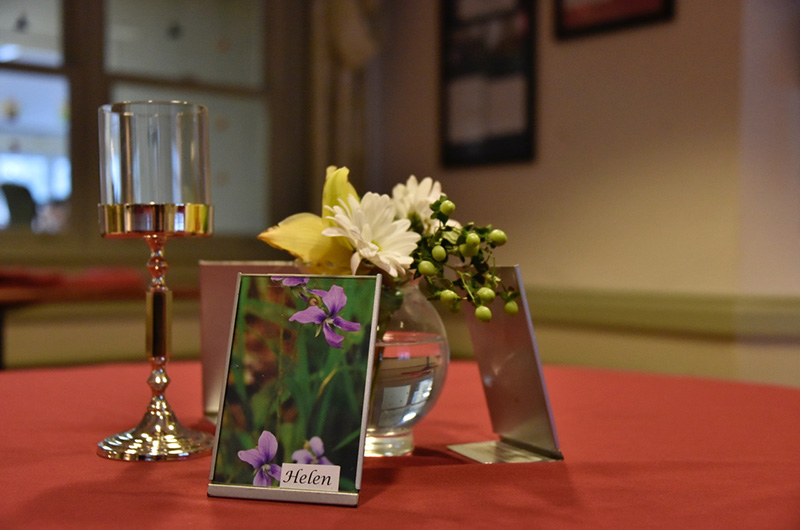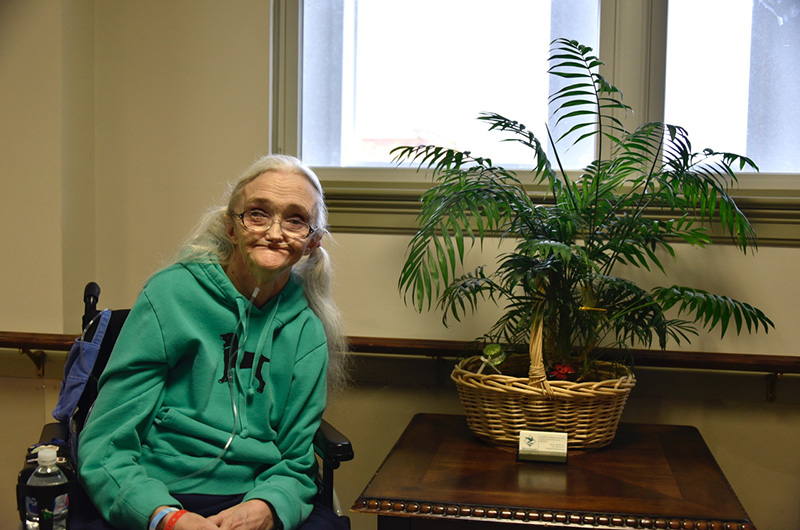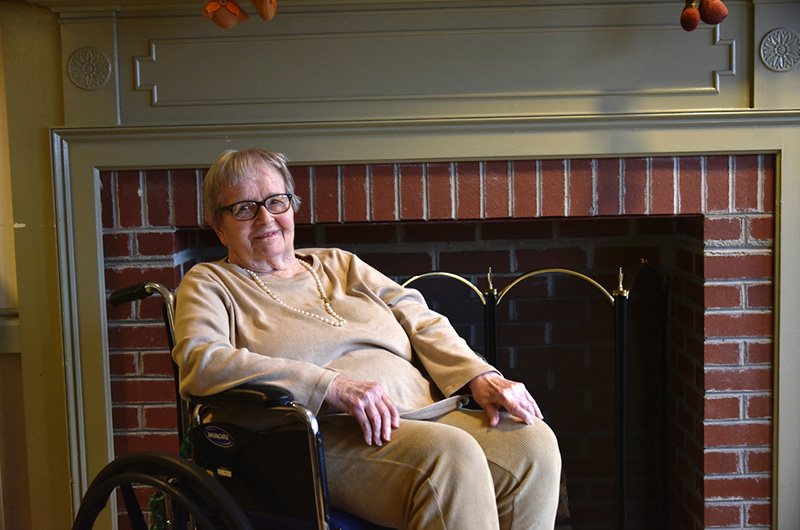Debbie Tucker has worked at the Windemere Nursing and Rehabilitation center since just after it opened in 1994. In that time, she has been a nurse’s aide, a licensed nurse, a secretary and a laundry worker. She grew up knowing many of the elders she now cares for.
“I’ve lived on this Island all my life, so most of these people I have known all my life,” she said.
Ms. Tucker understands more than most the connection the nursing home has to the Island. Her own father lived at Windemere at the end of his life, and other relatives have passed through too. Ms. Tucker worked at Linda Jean’s restaurant in Oak Bluffs for years before taking a job as a nurse’s aide. Many of her former regulars have become residents. She remembered taking care of a former Chilmark school teacher who lived to be 104, and seeing another future Windemere resident every year at the Fourth of July parade in Edgartown.
“He owned or worked at one of the hotels, and he used to sit out on the front porch,” she said. “Next thing I know, he’s in Windemere.”
As models for elderly care undergo rapid change both around the country and on Martha’s Vineyard, the Island’s only nursing home is facing challenges. A subsidiary of the Martha’s Vineyard Hospital that shares its campus, the five-star nursing home has been highly rated for its quality of care. But it operates at an annual loss of more than $1 million, according to hospital leaders.
The patient census is also shrinking. Once capable of serving 106 residents in four separate wings, Windemere today has 61 beds and two wings. As of early this fall there were 57 residents.
And as the community grapples with how best to care for a growing population of elders in the long term, Windemere and its staff continue to serve the small population that is a human repository for decades of Island memory and history.
“The way I think about it personally is Windemere is part of our overall care continuum on the Island, and I only think about it in financial terms secondly,” hospital president and chief executive officer Denise Schepici said in an interview this week. She praised the staff and the quality of care at the facility. “As challenging as it is from an administrative perspective, I don’t think that’s what the day-to-day team is thinking about. Those other challenges are for me, the board, and the community to worry about,” Ms. Schepici said.
Ms. Schepici and others, including the Martha’s Vineyard Commission and Healthy Aging Martha’s Vineyard, have begun preliminary studies and planning aimed at developing new models for long-term care on the Island. The hospital has contracted with Navigator Elder Homes of New England to conduct a feasibility study based on the Green House model.
“We’re very committed to doing the right thing for the Island,” Ms. Schepici said. “I’d say it’s a major part of my daily work making sure that goal stays front and center and that I can shepherd and steward a result that makes sense.”
Meanwhile, the hospital is working its way through the permitting process to convert vacant areas of Windemere into offices, including extra space for the growing primary care department. Ms. Schepici said she hopes to see those spaces occupied by next summer.
At Windemere, about 90 per cent of residents are enrolled in the state’s Medicaid program MassHealth, according to nursing home administrator Mathew Muratore, who came onto the job last year. The standard charge for living at the facility is $378 per day, or $11,340 per month. MassHealth pays an average of $238 per day, or $7,140 per month, according to the hospital’s chief financial officer, Edward Olivier. The cost to provide care is about $361 per day, or $10,830 per month.
In fiscal year 2017, Windemere’s operating loss totalled more than $1.5 million. In fiscal year 2018 after the closure of the independent living wing Wildflower Court, the operating loss dropped slightly to about $1.2 million, Mr. Olivier said. Windemere’s annual budget is about $8 million.
As with many Island institutions, high housing costs pose barriers when it comes to staffing. While, like Ms. Tucker, some staffers have worked at Windemere for years, Mr. Muratore said 65 per cent of the facility’s 60 employees are temporary workers known in the business as travelers, spending a rotation of about three months working at Windemere before going elsewhere. The hospital helps to provide housing for many temporary workers.
Other challenges involve gender mix among residents. As of early fall, 52 of the facility’s 57 residents were women. Rooms are configured around communal, single-gender bathrooms, which means if one bed opens up in a women’s cluster, it cannot be converted to accommodate a male unless the whole cluster is converted.
“Male gender is our number one reason for turning people away,” Mr. Muratore said. He said there are eight people on the nursing home’s waiting list.
Administrators say the average length of stay at the facility is three and a half years, while the average age of residents is mid-80s.
In areas that are being used, Windemere is full of activity. Teachers from The Yard in Chilmark lead regular dance classes. Musicians visit for sing-alongs and performances. The walls in the dining room are decorated with essays by Island students about conversations with Windemere residents.
“Everyone has to always be aware that this is [the residents’] home, and we are in it,” said Paula Morris, another longtime staffer. “They love bowling, they love bingo, they love going to concerts, and we have great relationships in the towns around us . . . so we can take them places.”

Fran Maciel has been at Windemere for about three and a half years. She has lived on the Vineyard since the 1960s, raising her four children and working retail in stores including Rainy Day and CB Stark Jewelers in Vineyard Haven.
Sitting in the dining room at a table looking out onto the patio, she said it took a while to adjust to living at the nursing home and sharing a room with a roommate, but she has gotten involved in the many activities there, from dance to exercise to painting at Featherstone. For her, one highlight is going out to see the Christmas lights, while another has been a yearly excursion on a volunteer’s catamaran.
“She treats us to that sail. It’s beautiful, absolutely beautiful to be out on the ocean like that,” Ms. Maciel said. “I would never have had anything like that, like people think you know, that because you’re in a rest home you don’t do anything, you know but you can be busy all day if you want to be.”
“It can be positive and negative, and most times it’s positive,” she said of living at Windemere. “I feel secure. I feel safe. I feel medically safe.”
Nancy Nitchie turns 90 next month. She grew up summering on the Vineyard and remembers learning to sail on the Island as a child.
“I think I’m fourth generation,” she said. “My husband taught here for a while and some of my uncles and aunts were school teachers or did things in the towns.”
She echoed that the transition to Windemere was challenging and said she enjoys gardening on the patio.
“I think Windemere does a wonderful job for what it is,” she said, adding: “There’s some very good people on the staff. There really are. I admire them.”
Hilda Illingworth lived in Warren, R.I., before moving to Windemere. She said she was thankful to have found a home in the place where she spent so many summers as a child.
“I’m kind of at a lack for words but every community should have a Windemere but they don’t, and that’s a shame,” she said.
Ms. Morris said financial straits aside, the care Windemere provides is invaluable.
“I guess it depends on what your perspective is with that because for me, we’re all in this together,” she said. “I personally feel that with the increase of the elderly communities here, and I see it with my parents . . . I myself don’t like to see Island people have to go off-Island.”









Comments (4)
Comments
Comment policy »